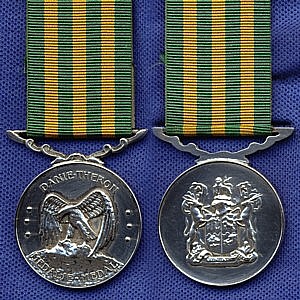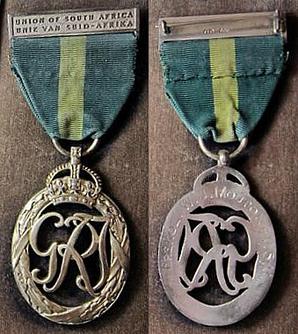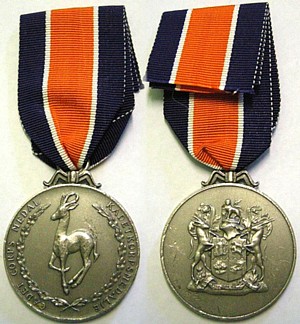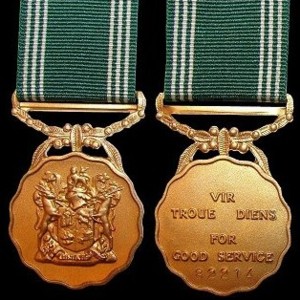
The Medalje vir Troue Diens - Medal for Loyal Service was instituted by the President of the Republic of South Africa on 16 April 2003 and came into effect on 27 April 2003. It can be awarded to all ranks whose character and conduct have been irreproachable and who have completed ten years of qualifying service.

The Honoris Crux of 1952, post-nominal letters HC, is a military decoration for bravery which was instituted by the Union of South Africa in 1952. It was in use from 1952 to 1975 and was awarded to members of the South African Defence Force for gallantry in action against the enemy in the field. It was discontinued on 1 July 1975, when it was replaced by a new set of four Honoris Crux decorations, in four classes.

The Dekoratie voor Trouwe Dienst, post-nominal letters DTD, is a South African military decoration. It was instituted in 1920 as a retrospective award for Boer officers of the 1899–1902 Second Boer War.

The Lint voor Verwonding is a South African military campaign award. It was instituted on 21 December 1920 as a retrospective award for Boer veteran officers and men of the 1899–1902 Second Boer War who had been wounded in action.

The Pro Merito Medal of 1967, post-nominal letters PMM, is a military decoration which was instituted by the Republic of South Africa in 1967. It was awarded to other ranks of the South African Defence Force for outstanding devotion to duty and was the non-commissioned officers' version of the Southern Cross Medal of 1952 (SM), which had earlier been available to all ranks.

The Danie Theron Medal, post-nominal letters DTM, is a military decoration which was instituted by the Republic of South Africa in 1970 and which was in use until 1993. It was awarded for diligent service in the Commandos, the rural defence component of the South African Defence Force. Originally reserved for officers, it was available to all ranks from 1975.

The Jack Hindon Medal, post-nominal letters JHM, is a South African military decoration which was instituted in the Republic of South Africa in 1970 and which was only in use until 1975. It was awarded to other ranks for diligent service in the Commandos, the rural defence component of the South African Defence Force.

The Permanent Force Good Service Medal was instituted by the Republic of South Africa in 1961, when South Africa became a republic, to replace the Union Medal. It was awarded to Permanent Force members of the South African Defence Force for eighteen years of service and good conduct.

The John Chard Decoration, post-nominal letters JCD, was a military long service decoration which was instituted by the Union of South Africa on 6 April 1952. It was awarded to members of the Citizen Force of the South African Defence Force for twenty years of efficient service and good conduct. Clasps could be awarded after thirty and forty years service respectively.

The Efficiency Decoration (South Africa), post-nominal letters ED, was instituted in 1930 for award to efficient and thoroughly capable part-time officers in the Citizen Force of the Union of South Africa after twenty years of service. The decoration superseded the Colonial Auxiliary Forces Officers' Decoration.

The John Chard Medal is a military long service medal which was instituted by the Union of South Africa on 6 April 1952. Until 1986, it was awarded to members of the Citizen Force of the South African Defence Force for twelve years of efficient service and good conduct. The period of qualifying service was reduced to ten years in 1986.

The Cadet Corps Medal is a military medal which was instituted by the Republic of South Africa in 1966. It could be awarded to officers in the School Cadet Corps for twenty years efficient service. A clasp could be awarded after 30 years qualifying service.

The Southern Cross Medal of 1975, post-nominal letters SM, is a military decoration which was instituted by the Republic of South Africa on 1 July 1975. It was awarded to officers of the South African Defence Force for exceptionally meritorious service and particular devotion to duty.

The National Cadet Bisley Grand Champion Medal is a military medal which was instituted by the Republic of South Africa in 1987. Originally named the Cadet Corps Grand Champion Shot Medal, it was awarded to the Grand Champion of the annual National Cadet Bisley of the School Cadet Corps.

The Pro Merito Medal of 1975, post-nominal letters PMM, is a military decoration which was instituted by the Republic of South Africa on 1 July 1975. It was awarded to other ranks of the South African Defence Force for exceptionally meritorious service and particular devotion to duty, and was the non-commissioned officers' version of the Southern Cross Medal of 1975 (SM).

The De Wet Medal is a military long service medal which was instituted by the Republic of South Africa in 1987. It was awarded to members of the Commandos, the rural defence component of the South African Defence Force, for ten years of efficient service and good conduct.

The Good Service Medal, Bronze, originally named the South African Defence Force Good Service Medal, Bronze, is the junior of a set of three South African military medals which was instituted by the Republic on 1 July 1975. It was awarded to members of all elements of the South African Defence Force for ten years of exemplary service, but was restricted to Permanent Force personnel from 1993.

The Good Service Medal, Gold, originally named the South African Defence Force Good Service Medal, Gold, is the senior of a set of three military medals which was instituted by the Republic of South Africa on 1 July 1975. It was initially awarded to members of all elements of the South African Defence Force for thirty years of exemplary service, but was restricted to Permanent Force personnel from 1993.

The Closure Commemoration Medal is a military commemoration medal which was instituted by the President of the Republic of South Africa in 2010, to commemorate the disbandment of the Commandos, the rural defence component of the South African National Defence Force.

The Service Medal in Gold was instituted by the President of the Republic of South Africa in April 1996. It was awarded to veteran cadres of Umkhonto we Sizwe, the military wing of the African National Congress, for thirty years exemplary service.




















